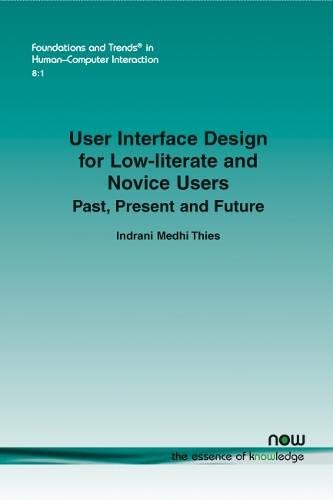User Interface Design for Low-literate and Novice Users: Past, Present and Future: 26 (Foundations and Trends® in Human-Computer Interaction) - Tapa blanda

Sinopsis
One of the greatest challenges in providing information and communication technology access is that about 775 million people in the world are completely non-literate and many are able to read only with great difficulty and effort. Even though mobile phone penetration is growing very fast, people with low levels of literacy have been found to avoid complex functions, and primarily use mobile phones for voice communication only.User Interface Design for Low-literate and Novice Users: Past, Present and Future looks at how we can design information and communications technology (ICT) user interfaces (UIs) in a way that novice and low-literate users can access a broad range of services and utilities, increasingly available to them, with minimal training and external assistance. It begins by observing the challenges in designing for low-literate users, and in conducting user studies among low-income communities in the developing world. It discusses techniques used by researchers in overcoming some of these challenges. It presents a review of existing examples of UIs for novice and low-literate users, which have used various combinations of input-output modalities other than text. It goes on to discuss strong trends that are starting to emerge in this design space and concludes with opportunities and future directions for research and design of UIs targeted at populations with low-literacy.User Interface Design for Low-literate and Novice Users: Past, Present and Future is relevant for anyone with an interest in user experience design and technology for global development.
"Sinopsis" puede pertenecer a otra edición de este libro.
Reseña del editor
One of the greatest challenges in providing information and communication technology access is that about 775 million people in the world are completely non-literate and many are able to read only with great difficulty and effort. Even though mobile phone penetration is growing very fast, people with low levels of literacy have been found to avoid complex functions, and primarily use mobile phones for voice communication only. User Interface Design for Low-literate and Novice Users: Past, Present and Future looks at how we can design information and communications technology (ICT) user interfaces (UIs) in a way that novice and low-literate users can access a broad range of services and utilities, increasingly available to them, with minimal training and external assistance. It begins by observing the challenges in designing for low-literate users, and in conducting user studies among low-income communities in the developing world. It discusses techniques used by researchers in overcoming some of these challenges. It presents a review of existing examples of UIs for novice and low-literate users, which have used various combinations of input-output modalities other than text. It goes on to discuss strong trends that are starting to emerge in this design space and concludes with opportunities and future directions for research and design of UIs targeted at populations with low-literacy. User Interface Design for Low-literate and Novice Users: Past, Present and Future is relevant for anyone with an interest in user experience design and technology for global development.
Reseña del editor
How can we design ICT user interfaces (Uls) such that novice and low-literate users can access the broad range of services and utilities that are increasingly available to them? Researchers in the domain of Human-Computer Interaction for International Development (HCl4D) have been investigating this question, exploring how Uls can be made more user-friendly for low-literate users. This short book examines the various challenges that have to be taken into account while designing these interfaces. It discusses issues of low formal education and low textual literacy, limited exposure to ICTs, and other cognitive challenges associated with low education. It then goes on to review different examples of UI research done over the last several years that have proposed non-textual designs. The focus is on research conducted in the context of non-literate adults.
"Sobre este título" puede pertenecer a otra edición de este libro.
Resultados de la búsqueda para User Interface Design for Low-literate and Novice Users:...
User Interface Design for Low-literate and Novice Users: Past, Present and Future (Foundations and Trends in Human-computer Interaction)
Librería: Phatpocket Limited, Waltham Abbey, HERTS, Reino Unido
Condición: Good. Your purchase helps support Sri Lankan Children's Charity 'The Rainbow Centre'. Ex-library, so some stamps and wear, but in good overall condition. Our donations to The Rainbow Centre have helped provide an education and a safe haven to hundreds of children who live in appalling conditions. Nº de ref. del artículo: Z1-T-002-03000
Comprar usado
Cantidad disponible: 1 disponibles
UI Design for Low-Literate and Novice Users: Past, Present and Future (Foundations and Trends in Human Computer Interaction)
Librería: Books Puddle, New York, NY, Estados Unidos de America
Condición: New. pp. 55. Nº de ref. del artículo: 26372471938
Comprar nuevo
Cantidad disponible: 4 disponibles
UI Design for Low-Literate and Novice Users: Past, Present and Future (Foundations and Trends in Human Computer Interaction)
Impresión bajo demandaLibrería: Majestic Books, Hounslow, Reino Unido
Condición: New. Print on Demand pp. 55. Nº de ref. del artículo: 373606237
Comprar nuevo
Cantidad disponible: 4 disponibles
UI Design for Low-Literate and Novice Users: Past, Present and Future (Foundations and Trends in Human Computer Interaction)
Impresión bajo demandaLibrería: Biblios, Frankfurt am main, HESSE, Alemania
Condición: New. PRINT ON DEMAND pp. 55. Nº de ref. del artículo: 18372471944
Comprar nuevo
Cantidad disponible: 4 disponibles
User Interface Design for Low-literate and Novice Users: Past, Present and Future (Foundations and Trends (R) in Human-Computer Interaction): 26 (Foundations and Trends® in Human-Computer Interaction) [Paperback] Medhi Thies, Indrani
Librería: Hay-on-Wye Booksellers, Hay-on-Wye, HEREF, Reino Unido
Condición: As New. Nº de ref. del artículo: 114533-8
Comprar usado
Cantidad disponible: 1 disponibles
User Interface Design for Low-literate and Novice Users: Past, Present and Future (Foundations and Trends(r) in Human-Computer Interaction)
Librería: Mispah books, Redhill, SURRE, Reino Unido
Paperback. Condición: Like New. Like New. Ships from Multiple Locations. book. Nº de ref. del artículo: ERICA77316019891806
Comprar usado
Cantidad disponible: 1 disponibles
